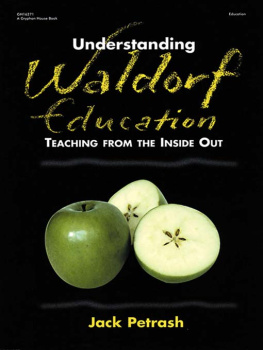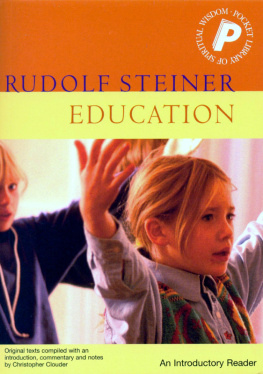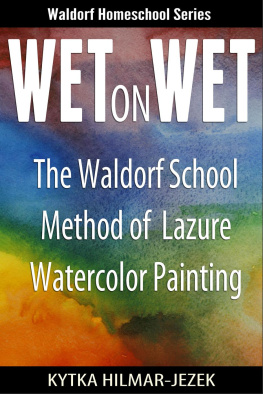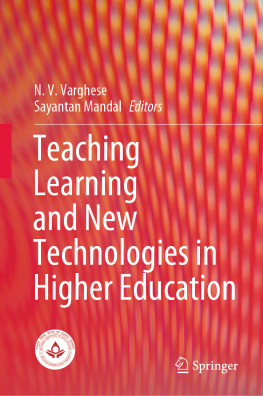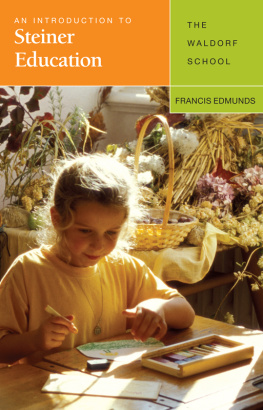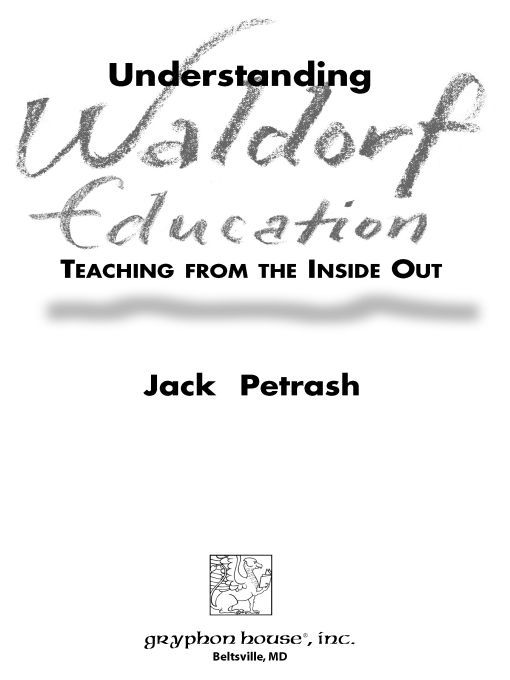Table of Contents
Dedication
For my wife, Carol, who has taught me so much from the inside out.
Acknowledgments
This book was made possible through the efforts of Richard Ailes, Barbara Bedingfield, the late Colonel Edward Imperato, and the generosity of Phyllis Norman. It was their foresight and their steadfast support and funding that made this project happen.
Many individuals helped to shape the educational ideas in this book, foremost among them, John Gardner, Lee Lecraw, and Sheldon Staff from the Waldorf Institute at Adelphi University, who provided me with a firm foundation in Waldorf education and helped me to understand what it takes to be a teacher. I thank them for setting the bar so high.
In addition there are my friends and colleagues at the Washington Waldorf School and, of course, my students who taught me so much about teaching and about myself. I thank them for their hard work, their enthusiasm, and most of all, for their patience.
Lastly, I want to thank those who assisted me in writing this book:
My colleagues at the Nova InstituteBarbarina Heyerdahl and Bruce Libonn
My editors, Kathy Charner and Kate Kuhn, whose expertise and sensitivity are woven together perfectly
Jerilyn Ray-Shelley, for her devoted camera work and her watchful eye E.F. Wen, for her beautiful border designs
Larry Conner and the Waldorf School of Baltimore for the photographs of some of their students
Vanessa and Tria Chang, Megin Charner, Charles Covey-Brandt, Emma Heirman, Sam Charner, and Ava Petrash for sharing examples of their work
And Chip Rood at Gryphon House, who is both friend and publisher
Foreword
The secrets of Waldorf schooling are the prize were after in spending time with Jack Petrash and his book, but oddly enough the best approach to Waldorf wisdom lies in first understanding the pedagogy of state schooling.
When Prussian one-size-fits-all schooling was brought to America in the middle of the 19th century by Horace Mann and others, this country had already been declared the best educated nation in history by the French essayist, Alexis DeTocqueville in his immortal classic, Democracy in America. The America he saw was a place of one- and two-room schools, a place where dozens and perhaps hundreds of schemes of education competed, drawing their strength from local traditions, local values, and citizen oversight, and the Prussian straightjacket was no part of this educational scene.
Its easy enough to hear about the excellent qualities of Waldorf education. Waldorf, invented by a Austrian philosophical genius named Rudolf Steiner, was first employed with the children of workers at the Waldorf-Astoria cigarette factory in Stuttgart, Germany after WWI in 1919. But the gulf between hearing of Waldorf and understanding it is vast. Thats where the book you are holding comes in.
The Steiner philosophy that drives Waldorf education is a philosophy in which human possibility is seen as infinite. Whatever premises about human nature you start with when you establish a school, the articulation of the system that emerges will inevitably reinforce those premises. In a sense, the shape of any school reflects its social architects deepest beliefs about humanity, and the best world possible.
Waldorf recognizes the genius in all and sets out quite deliberately to coax the muscles of that genius into playin a far different fashion than the pedagogical orthodoxy, as youre about to learn.
My own experience with Waldorf-educated children is overwhelmingly positive. Although a public school teacher myself for 30 years, Ive been fortunate enough as a public speaker on school reform to have been invited to lecture at Waldorf schools all over the country. What Ive seen on these trips has been a revelation to me of what might be possible.
I could launch into a presentation of the actual method, but for the fact that Mr. Petrash has already done that in fine fashion. I think youll find what he has to say illuminating. I know I did.
John Taylor Gatto,
Former New York State Teacher of the Year,
and author of:
Dumbing Us Down
A Different Kind of Teacher, and
The Underground History of American Education
www.johntaylorgatto.com
Readers interested in more information about Waldorf education and the location of Waldorf schools in North America can go to the website of the Association of Waldorf Schools of North America at www.awsna.org
Introduction
Several years ago, the MacArthur Foundation awarded one of its prestigious genius grants to Deborah Meier, a New York City principal from the East Harlem School District. She was commended for making three striking innovations in her public school. First, she recognized that 45-minute classes were not conducive to learning and so she restructured her schools schedule to create double periods in an effort to intensify and deepen the educational process. Second, she saw that effective teaching could not take place in isolation. Consequently, she instituted a program of inter-curricula instruction, the kind that could allow music teachers to help teach history or art teachers to help teach science and where written composition could be used to teach mathematics. Third, she asked the faculty to be part of the decision-making that would create school policies that would directly affect the work in their classrooms.
Meiers ideas spawned innovations in schools across the country. The time was right for change. But these ideas were not new. Just as there were environmentalists long before the first Earth Day, Waldorf Schools had been using these three educational principles for more than 75 years. Why was Waldorf the best kept secret in education?
This book is an attempt to make the Waldorf approach more widely known and show how some of the most positive reforms occurring in schools today closely parallel the work that Rudolf Steiner began with the first Waldorf School in the early part of the 20th century. It is my hope, also, that this book will convey some of the fundamental principles of Waldorf education in language that is accessible so that parents, teachers, and future teachers will understand the essential aspects of this delightful, practical, and healthy approach to education.
CHAPTER ONE
Broadening Horizons
Waldorf education places the development of the individual child in the focal point, convinced that the healthy individual is a prerequisite for a healthy society.
The International Conference on Education of UNESCO
Third-grade students have arrived at school early on a Sunday morning. Their suitcases are being loaded onto a bus to take them on a five-day trip to a working dairy farm in upstate New York. On the farm they will help bring in the cows, muck the barn, gather the eggs, and experience a different way of living. This is an important event for the children. For many of them, it is the first time that they will be away from their parents. The students have been preparing for this trip for a long time, knowing that all of the third graders at this school go on the Farm Trip. It is a rite of passage, something that fills the students with anticipation and with a certain amount of anxiety.

